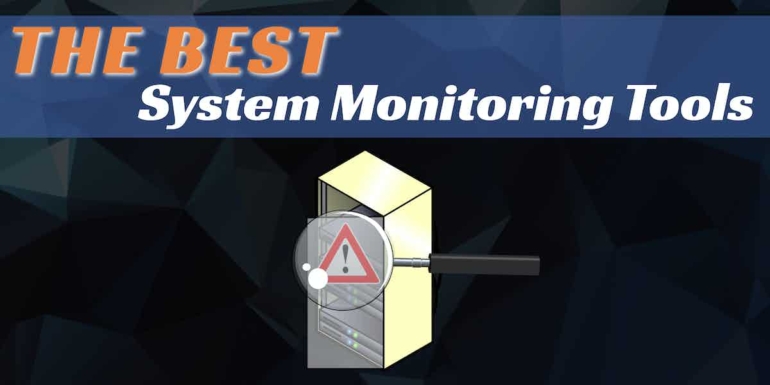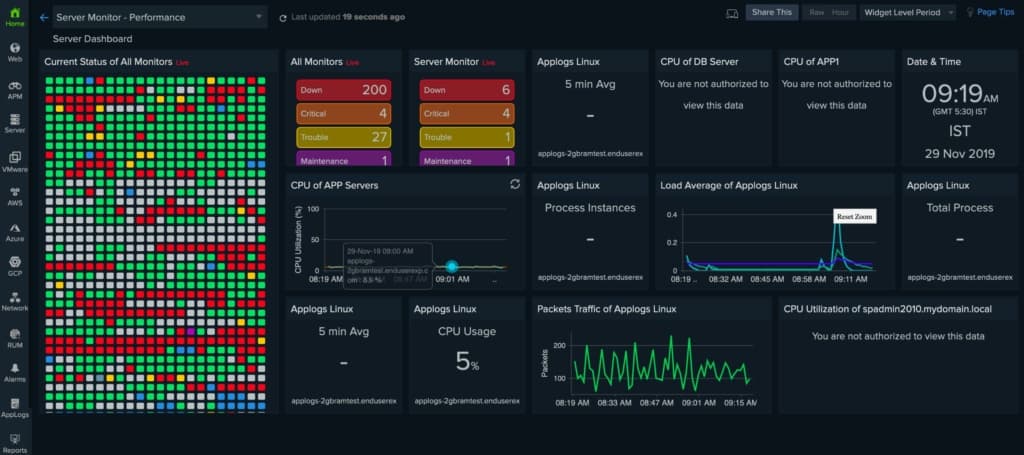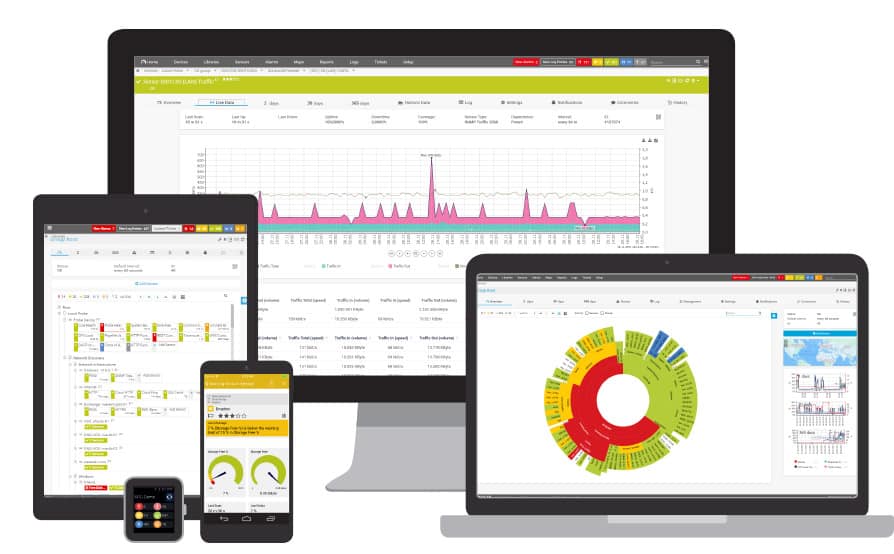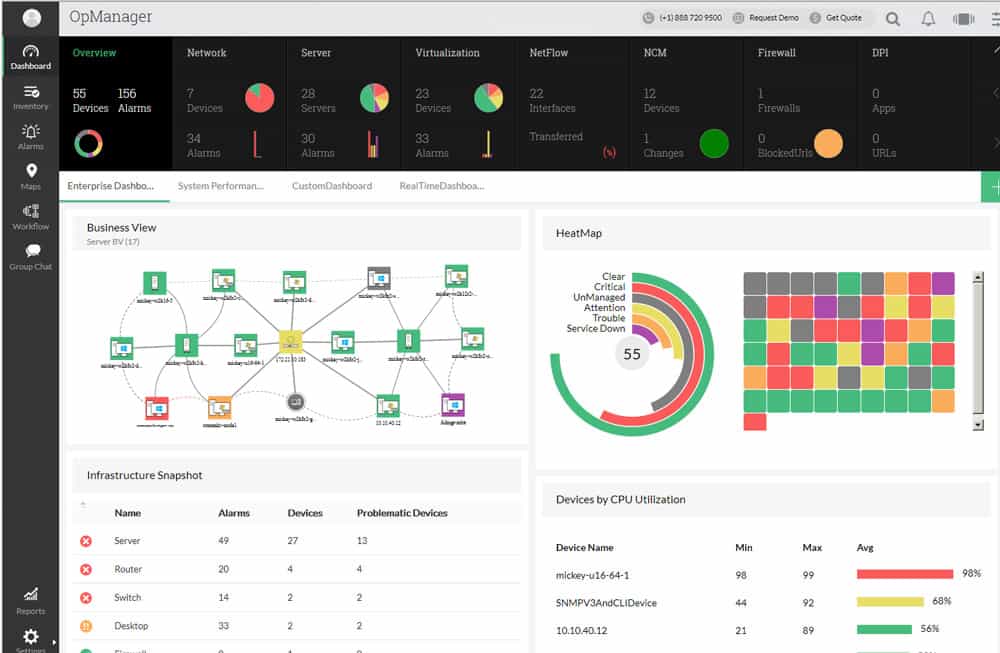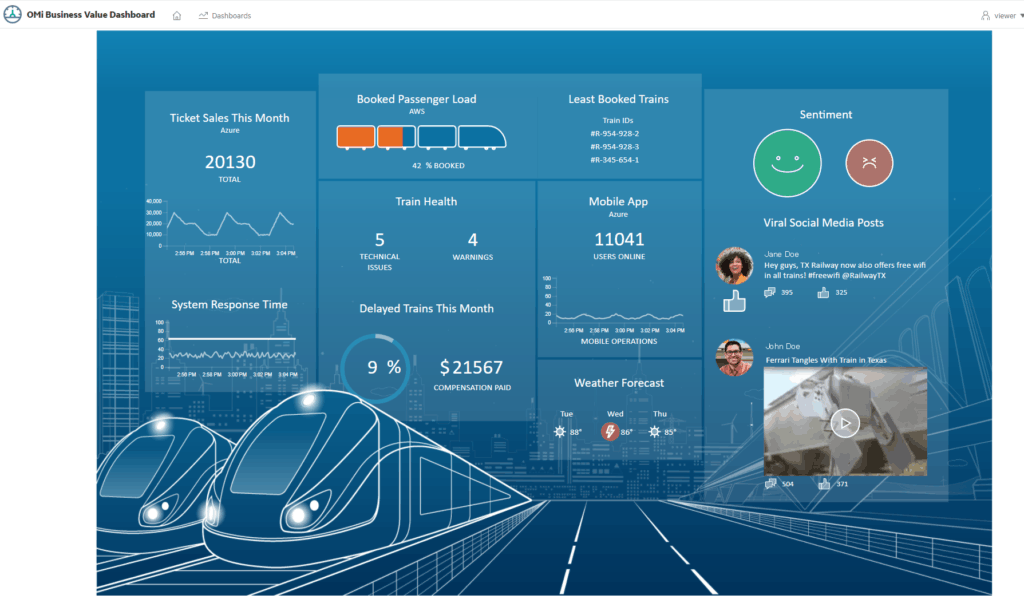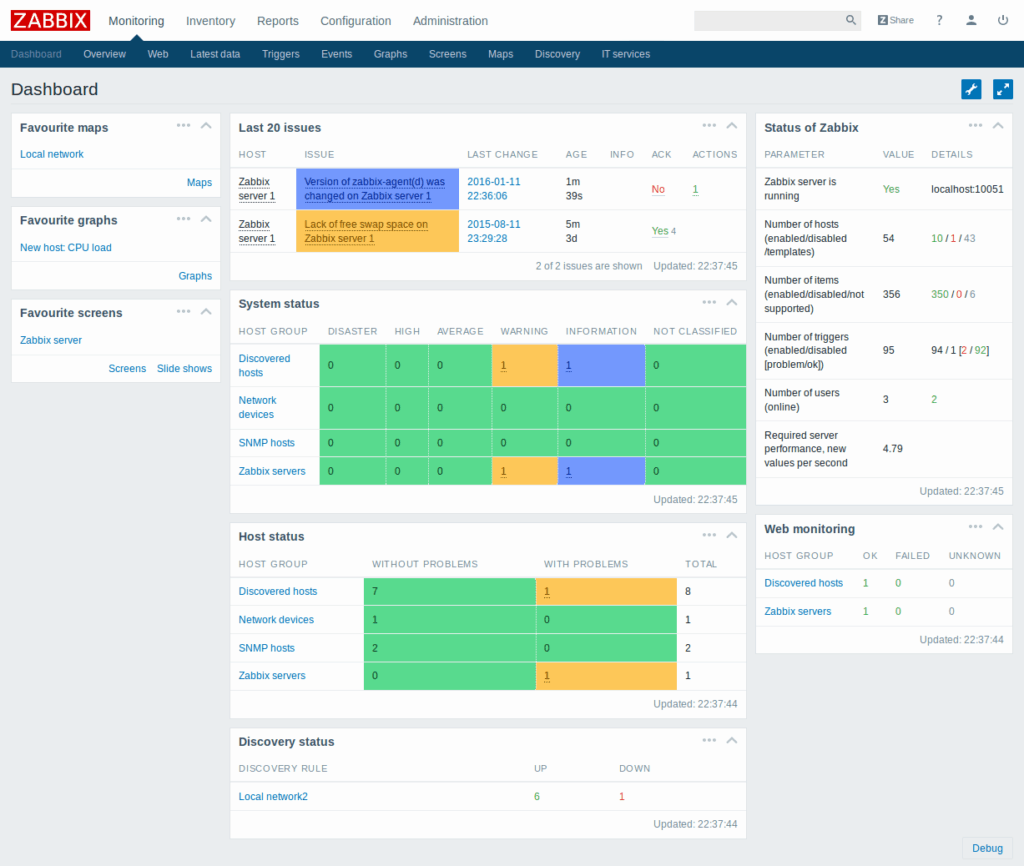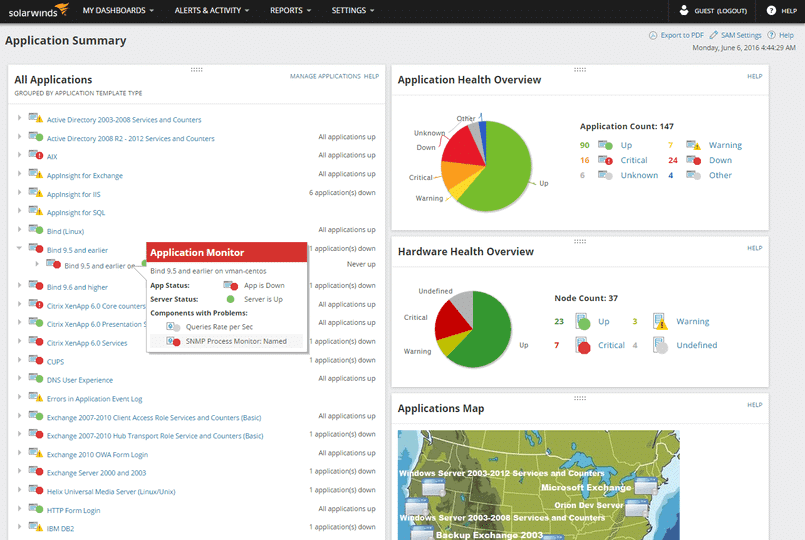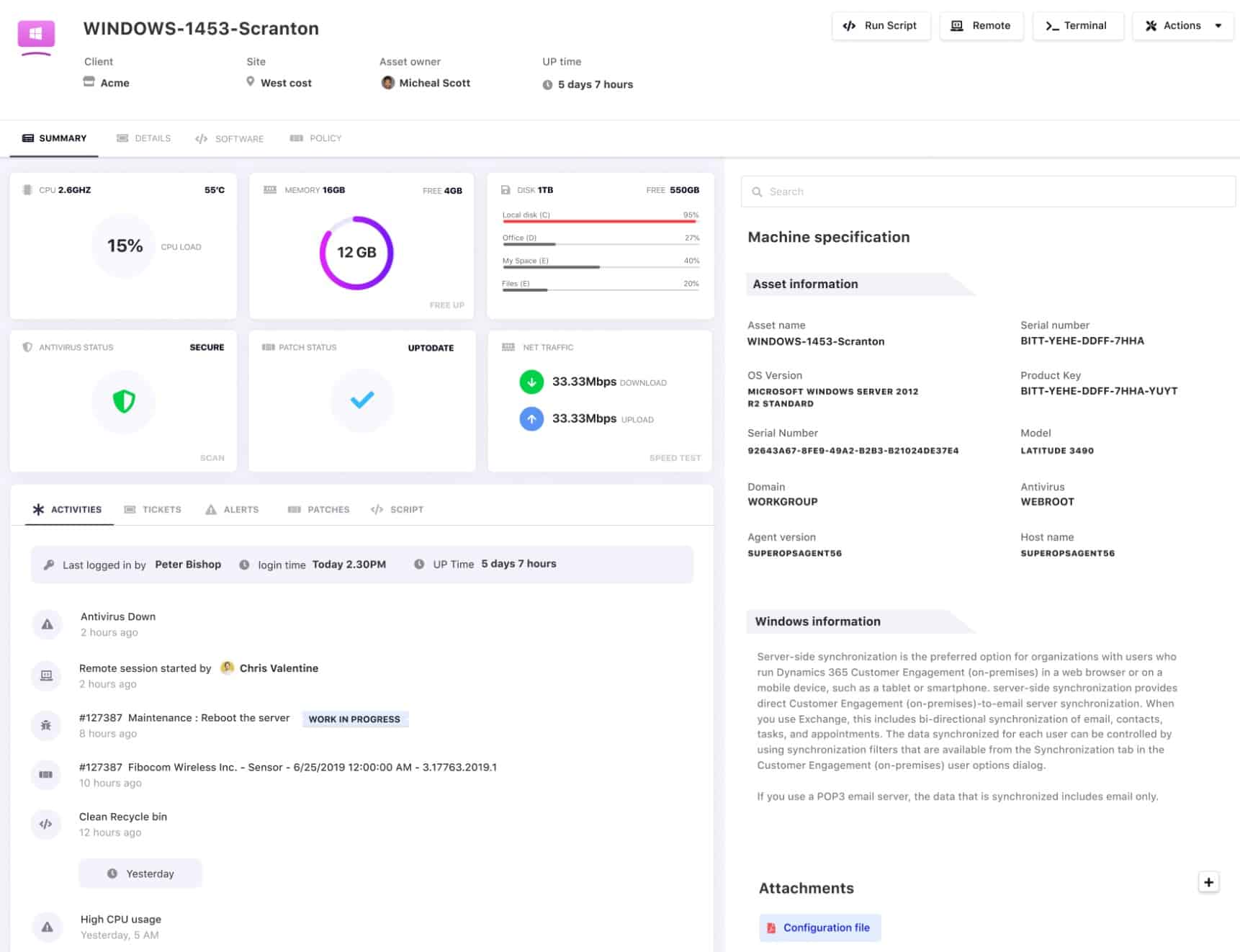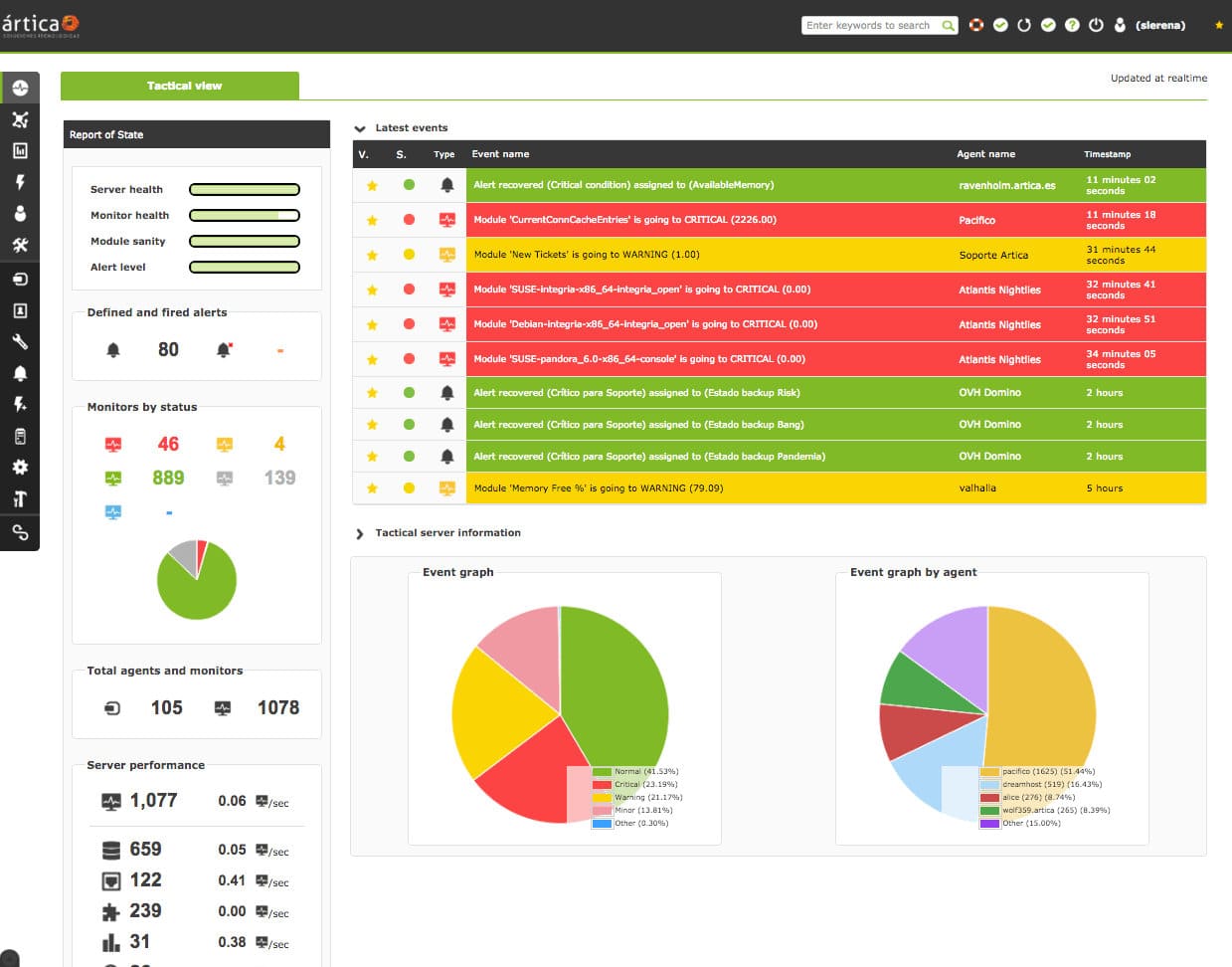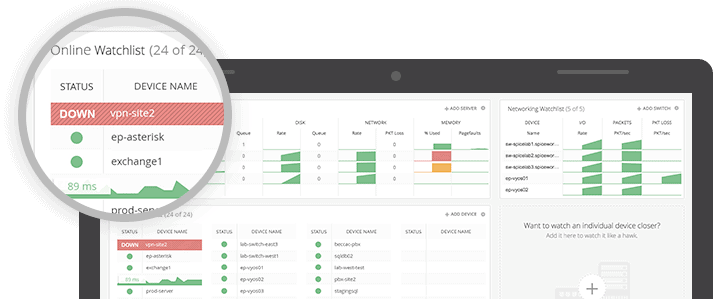Finding the Best System Monitoring Tools and software will help you manage all Windows, Linux, mac and other devices from a centralized dashboard and give complete control over your Server Infrastructure and Network.
These tools monitor every aspect such as networks, servers, computers, devices, and more, and in the process, help you stay on top of security and performance.
There are many monitoring tools available for the Windows environment and here’s a look into some of the top tools.
Here’s our list of the best system monitoring tools:
- NinjaOne – FREE TRIAL A remote monitoring and management package that creates a hardware inventory and then manages the software on all devices. This is a SaaS package. Start a 14-day free trial.
- Site24x7 – Infrastructure Monitoring – FREE TRIAL A cloud-based monitor for networks, servers, and applications that links the application stack from front-end software down through to demand on server resources. Start a 30-day free trial.
- Paessler PRTG – FREE TRIAL A package of infrastructure monitoring tools that includes network performance management features. Installs on Windows Server. Start a 30-day free trial.
- ManageEngine Applications Manager & OpManager – FREE TRIAL A complete software and hardware monitoring package created by two monitoring modules. Both install on Windows Server and Linux. Start a 30-day free trial.
- Operations Bridge An infrastructure monitoring system that can track resource utilization over a network, across the internet, and on remote servers.
- Zabbix A free suite of on-premises monitoring software that tracks the performance of networks, servers, and applications. Control software runs on Linux, Unix, and macOS, agent software runs on all of those OSs plus Windows and Windows Server.
- SolarWinds Server & Application Monitor A server monitoring system that tracks resource utilization and also application performance on servers. The software installs on Windows Server but the system can also monitor Linux servers over a network.
- SuperOps – RMM This SaaS module on a cloud platform provides full system monitoring, including endpoint monitoring for workstations and servers running Windows and Linux.
- Pandora FMS An infrastructure monitoring system that installs on a bare metal server. This system includes network, server, and application monitor tools.
- Spiceworks Network Monitor A free, online connectivity monitor that focuses on checking website availability.
Windows environments come with a built-in monitoring tool called “Task Manager” that gives a bird’s eye view of the running processes, CPU usage and memory. But, it doesn’t have advanced features such as alerting and reporting.
This is why it’s a good idea to use advanced monitoring tools in addition to Task Manager, to keep your infrastructure in good health and your up-time high!
The Best System Monitoring Tools
Methodology for selecting the Best System Monitoring Software & Tools
- Does it support remote system monitoring?
- Can you track cloud resources?
- Does it offer automated network discovery and software inventory compilation?
Below your find a quick description of each software we recommend along with Download links as well.
1. NinjaOne – FREE TRIAL
NinjaOne – formerly NinjaRMM – is a cloud platform that provides all of the tools needed to monitor and manage a remote system. This package is particularly aimed at the technicians of managed service providers (MSPs) but it is also a good choice for IT operations departments.
This service is particularly good at managing devices running Windows, Windows Server, and macOS. Although the service is able to monitor Linux devices across a network, it doesn’t have endpoint agents for that operating system.
Key Features
- Complete system management that covers networks, endpoints, and software
- A ticketing system that enables technician team management
- Automated monitoring processes that issue alerts when problems are detected
- A patch manager that will automatically update software
- A network traffic monitor as well as a device status supervisor
- Monitoring of device resource usage
- A multi-tenanted service that keeps the data of many clients separate
Why do we recommend it?
NinjaOne offers a comprehensive cloud-based platform specifically designed for managed service providers and IT departments. With features like automated monitoring processes, real-time alerts, and a patch manager, it streamlines system management across different types of operating systems and devices.
NinjaOne is a great package for a focus on system management. The platform can be enhanced with third-party tools that integrate with the NinjaOne system and exchange data.
Who is it recommended for?
NinjaOne is ideal for managed service providers (MSPs) looking for a tool that can help them manage multiple client networks, endpoints, and software all from one console. It’s also a solid choice for IT departments that require an all-in-one solution for monitoring and managing remote systems and endpoints, especially those running on Windows and macOS.
Pros:
- Monitor and Manage endpoints, software, networks, and even remote systems
- Generates context-rich alerts using endpoint health and performance metrics collected in real-time
- Using the single console, you can monitor all your endpoints and workstations
- Enables you to launch automated workflows to fix incoming issues
- Identifies and eliminates an unauthorized application
Cons:
- Active Directory Integration is not available
The company doesn’t publish a price list, so you need to request a quote. NinjaOne is available on a 14-day free trial.
2. Site24x7 Infrastructure Monitoring – FREE TRIAL
Site24x7 is a cloud-based network infrastructure monitoring tool that is ideal for monitoring systems primarily through how their servers are performing. It’s great for debugging issues in real-time and gives you insights into Windows and Linux processes that are running.
Key Features
- Application stack mapping to discover demand for server resources.
- Typical server metrics, such as CPU, memory, and disk capacity and load.
- Live performance tracking plus historical data analysis.
- Server capacity planning support.
- Alerts on performance thresholds.
- Problem notification by SMA, email, voice call, or instant messaging post.
- A customizable Web-based dashboard.
- The ability to unify the monitoring of servers on different sites.
- A hosted service that includes processing and storage plus constantly updated software.
- The collection and management of system and application log messages.
Why do we recommend it?
Site24x7 offers robust, cloud-based monitoring that excels in real-time problem detection and historical data analysis. Its ability to unify the monitoring of servers across different sites, along with multiple channels for problem notification, makes it an outstanding tool for maintaining server performance.
Who is it recommended for?
This tool is particularly useful for organizations that require an in-depth, real-time understanding of server metrics like CPU usage, disk capacity, and load time. It’s also a strong fit for businesses that have servers located at multiple sites and need to consolidate their monitoring in one place.
Pros:
- Debug issues and generate insights in real-time
- Map the application stack to identify if there is any need for server resources
- Track disk capacity, CPU usage, load time, and other server metrics
- Notifies via voice call, SMS, email, or instant messaging post
- Performs historical data analysis and allows tracking of live performance
Cons:
- UI needs to be improved
Site24x7 Infrastructure is a subscription service that costs $9 per month when paid for annually. You can get it on a 30-day free trial.
3. Paessler PRTG – FREE TRIAL
Paessler is another extremely well know software company that is based out of Germany with deep roots in Network Monitoring and Management. They offer a very robust solution for managing your network devices, servers and applications with their flagship product, PRTG Network Monitor.
PRTG can either be downloaded and installed locally on a server or they now have a Hosted solution for those who want to have monitoring off-premises.
Key Features
- VM Monitoring & Management with pre-configured templates
- SQL & Exchange Mail Server Management & Monitoring solutions
- IIS Application Server monitoring
- More Critical components via WMI & SNMP including CPU, Memory, Traffic stats and more!
- Citrix System Monitoring
- Syslog and Event Log Analysis
- Linux, Unix & Mac OSX System Support
Why do we recommend it?
Paessler PRTG Network Monitor excels in offering a wide range of monitoring capabilities, from VM and Mail Server Management to system-specific monitoring like Linux, Unix & Mac OSX. Its flexibility and preconfigured templates make it a robust and quick-to-implement solution for network monitoring and management.
PRTG is well-rounded and very flexible out of the box. It includes many pre-built templates to quickly jump into whatever system management task you throw at it.
Who is it recommended for?
PRTG is suitable for businesses of all sizes looking for a comprehensive monitoring solution. Whether you prefer an on-premises or cloud-based approach, PRTG caters to both. It’s particularly useful for IT teams that manage diverse infrastructure and require quick, template-based configurations.
Pros:
- Allows keeping track of all types of infrastructure
- Suitable for the environment of all sizes, including small, mid, and large
- Hosts on-premises as well as cloud-based monitoring
- The automatic network discovery features help in quick configuration
- Set custom thresholds and send instant alerts on detecting issues
Cons:
- Multiple Linux machine management creates an issue
First 100 Sensors free! 500 Sensors – $ 1,600, 1000 Sensors – $ 2,850, 2500 Sensors – $ 5,950, 5000 Sensors – $ 10,500, XL1 unlimited – $ 14,500, XL5 unlimited – $ 60,000
You can start a fully functional 30-day free trial.
4. ManageEngine Applications Manager & OpManager – FREE TRIAL
An IT system is made up of both hardware and software, so, to get a full system monitoring overview, you need to cover both of these resource categories. ManageEngine provides OpManager to monitor hardware – mainly network devices and servers. The company’s Applications Manager monitors software. So, a combination of the two covers all IT infrastructure. Both modules are written on a common platform, so they slot together.
The connection between software and hardware is particularly important when managing services that require both elements to exist, such as virtualizations. In other cases, such as website performance, the causes of problems could easily be due to software, hardware, or issues with combinations of the two.
Key Features
- Network device health checks
- Server resource monitoring
- Cloud server status tracking
- Internet connection monitoring
- Website performance testing
- Application dependency mapping
- Network topology mapping
- Status impairment alerts
Why do we recommend it?
ManageEngine’s combination of OpManager and Applications Manager offers a comprehensive view of both hardware and software, making it a one-stop solution for IT infrastructure monitoring. Its features like server resource monitoring, cloud status tracking, and proactive anomaly identification make it stand out.
The connection between these two modules enables a system administrator to map and document all resources automatically. The alert system in both tools can be forwarded as notifications by email or SMS message, which means that system monitoring is automated because technicians can leave the tool to watch over normal operations, being drawn back to the system console only when needed.
Who is it recommended for?
This solution is ideal for system administrators and IT teams who need a unified view of their entire IT landscape. It’s particularly beneficial for environments that rely heavily on both hardware and software functioning seamlessly together, such as those using virtualizations or complex application dependencies.
Pros:
- Run scans to check the health status of your network devices
- Allows tracking server resources and cloud server status
- Generate code-level insights and trace distributed transactions
- Create insightful reports covering response time, performance by browser, etc.
- Proactive identification of anomalies based on changing baselines
Cons:
- Topology mapping needs attention
ManageEngine offers a 30-day free trial of both OpManager and Applications Manager. Get in touch with the sales team for a personalized quote.
5. Operations Bridge
Operations Bridge from Micro Focus is a containerized monitoring solution that works well on Windows. Based on more than fifty patents for high-volume data analysis and speed, this tool monitors the entire infrastructure efficiently.
Key Features
- Containerization helps to automate many routine IT tasks.
- Deployment can be done in public or private cloud.
- Business Value dashboards give the real-time status of different metrics.
- Automated discovery model tracks changes in a visually-appealing way.
- Supports the monitoring of cloud services and SaaS applications to understand any issues or under-performance.
- Machine learning helps with predictive analytics
- Offers integration to a ton of popular IT service management tools.
- Automatic log, metric and event analysis
- Integrates all AI Ops capabilities
- Allows the use of HTML 5 policy editors to handle the generic output from Windows event log.
Why do we recommend it?
Operations Bridge from Micro Focus excels in high-volume data analysis and automation, backed by more than fifty patents. Its containerization for automating routine tasks and machine learning capabilities for predictive analytics set it apart in the market.
Who is it recommended for?
This tool is well-suited for organizations that are looking for advanced analytics and automation in their monitoring solutions. If you need real-time metric dashboards, AI-driven predictive analytics, and seamless integration with IT service management tools, then Operations Bridge is an excellent choice.
Pros:
- Quickly tracks and remediates issues
- Use AI to manage symptomatic alerts
- Automate daily tasks using containerization
- A visually appealing automated discovery model records all changes and modifications
- Allows integration with IT service management software
Cons:
- Complex initial setup
- Requires multiple servers
There are two editions – Express and Ultimate. The price of Express edition for 50 nodes is $18,425 and the Ultimate edition for 50 nodes costs $91,830. A free trial can be downloaded from here.
6. Zabbix
Zabbix is an enterprise-class open-source network monitoring solution to track and monitor network services, software, devices and hardware. Created by Alexei Vladishev from Latvia, this tool can monitor millions of metrics collected form thousands of devices.
Key Features
- Supports different metric collection methods and protocols such as SNMP, IPMI and IPv6.
- Offers flexible data gathering
- Pre-processes collected data
- Automatically discovers network devices
- Notifies any device configuration changes, as soon as they occur.
- Comes with out-of-the-box templates to monitor all metrics.
- Has configuration templates to update thousands of network devices simultaneously.
- Creates complex logical expressions to make it easy to identify problems.
- Defines trigger security levels to help users focus on the most important problems.
- Supports many alert notifications such as SMS, email, custom scripts, jabber and more.
- Allows users to run remote scripts on monitored devices.
- Integrates well with third-party software
- Encrypts all traffic between Zabbix and the monitoring device
- Uses LDAP authentication and pre-determined user permissions.
- Comes with no limitations or hidden restrictions. Everything is completely free.
Why do we recommend it?
Zabbix stands out for its comprehensive suite of features, including various metric collection methods, automatic network device discovery, and robust alerting capabilities. Its open-source nature and enterprise-class functionalities make it a go-to choice for monitoring networks.
Who is it recommended for?
Zabbix is ideal for businesses of all sizes that require a versatile and secure monitoring solution. Its ability to integrate with third-party software and support for multiple alert notifications make it especially suitable for complex IT environments. The tool is also perfect for organizations looking for a cost-effective, yet powerful, monitoring solution since it is completely free.
Pros:
- Alerts on discovering changes in the device configuration
- To spot issues, it creates complex logical expressions
- Supports integration with third-party software
- All traffic between Zabbix and monitoring devices is encrypted for security purposes
- Zabbix is completely free and has no restrictions
Cons:
- More comprehensive UI/UX
- More templates would be better for detailed tracking.
Zabbix is free to use.
7. SolarWinds Server & Application Manager
SolarWinds Server & Application Manager is a systems manager that offers excellent visibility into the performance of applications and servers. Its One of our Top Picks for monitoring Systems within your Network along with applications that run on them as well.
We Highly Recommend SolarWinds Server & Application Manager due to its extensive feature sets as well as their constant updates to the software that make it an All around great tool for utilizing in your network.
Below your find a list of capabilities and features that it has integrated that make it one of the most Popular Tools available today for the Windows environment, as well as monitoring other systems including Virtual Machines, UNIX/LINUX Server software and more!
Key Features
- Multi-vendor systems can be monitored from a single console
- Scalable, and supports anything ranging from a handful of devices to multi-site deployments.
- Sends proactive alerts to inform users before an issue spirals into a problem that could impact businesses negatively.
- Helps to identify the root cause of the problems, so they can be fixed quickly.
- Comes with pre-packed monitoring templates and reports, so you can get started right away.
- New templates can be built or existing templates can be modified to meet specific preferences.
- Easy to install and the entire process can be completed in less than half an hour.
- Helps with capacity planning.
- Supports more than 200 applications spread across different environments including Windows.
- Helps to monitor hardware components like fan speed, temperature, power supply and more.
- Tracks assets throughout their life-cycle.
- Monitors both physical and virtual applications and servers.
Why do we recommend it?
SolarWinds Server & Application Manager stands out for its extensive feature set and proactive monitoring capabilities. The tool excels in giving users clear visibility into both application and server performance, and its ability to send proactive alerts allows issues to be remediated before they impact business operations.
On top of these features, SolarWinds Server & Application Manager offers three out-of-the-box templates designed specifically for Microsoft Exchange, IIS and SQL Server. These templates help to solve complex problems using advanced monitoring techniques as well as Reporting issues that arise quickly.
- Exchange Server – Helps to view mailboxes, storage levels and statuses, monitors user activity and identifies replication problems.
- Microsoft IIS – Monitors the availability of websites and applications, reports SSL expirations and allows users to remotely start or stop application pools.
- SQL Server – Monitors database connections, error logs, index fragmentation and more.
Who is it recommended for?
This solution is highly recommended for businesses of all sizes, especially those with multi-vendor and multi-site deployments. It’s a particularly good fit for IT managers and administrators who need deep insights into application and server performance, and who are responsible for ensuring uptime and reliability across various system environments, including Windows, UNIX, and LINUX.
Pros:
- clear visibility into application and server performance
- Watch over multi-vendor systems
- Sends proactive alerts
- Identifies the root cause of the issue and remediates it instantly
- Offers multi-site deployments and insightful reports for informed decisions.
Cons:
- Fully exploring can be time-consuming as it has many features
Download your 30-day free trial to get started.
8. SuperOps RMM
SuperOps RMM provides a remote monitoring and management (RMM) SaaS package and also a professional services automation (PSA) module from its cloud server. The RMM system includes watches over servers and workstations running Windows and Linux and it also monitors software and networks.
Key Features
The SuperOps RMM system’s server monitoring services include:
- A multi-tenant architecture for MSPs
- Automated monitoring for use by IT departments
- Alerts for performance problems
- System resource availability monitoring
- Hardware discovery and inventory creation
- Automated software inventory management
- Software license management
Why do we recommend it?
SuperOps RMM excels in providing a comprehensive suite of monitoring tools, including both remote monitoring and professional services automation. The system’s multi-tenant architecture and automated features make it a reliable solution for optimizing server and software performance.
Server management tools in the RMM package include:
- A patch manager for Windows, Linux, and software packages
- Software deployment
- Maintenance automation
- IT documentation module
- Compliance reporting
- Associated PSA with a ticketing system
Who is it recommended for?
This tool is ideal for Managed Service Providers (MSPs) and IT departments that require automated, scalable solutions for monitoring servers and workstations. It’s also particularly useful for organizations that need to manage multiple tenants, oversee software deployments, and maintain compliance reporting.
The following plans include the RMM package. Prices are based on the annual payment plan:
- Standard RMM-only for $79 per technician per month
- Pro for $99 per technician per month
- Super for $129 per technician per month
Get a 14-day free trial.
9. Pandora FMS
Pandora FMS is an open-source monitoring software for IT infrastructure. It is ideal for Windows and Unix servers, networking equipment and all other kinds of applications.
Key Features
- Comes with events, graphs, customizable reports and dashboards to help you stay on top of any device’s performance and availability all the time.
- Supports different protocols and standards such as SNMP, WMI, Netflow, SNMP traps, remote plug-ins execution and more.
- Automatically discovers new devices and creates the network map accordingly.
- Supports a wide range of applications such as SAP, Oracle, Tomcat, IIS, DB2 and more.
- Comes with pre-built templates to start the monitoring process right away.
- Allows agent and agentless monitoring.
- Sends notifications through SMS, syslog, Slack, custom scripts and more.
- Scales well in large, complex and dynamic environments.
- Helps to create interactive graphs, where users can zoom out and point certain elements to accurately know the value of each element at any point in time.
Why do we recommend it?
Pandora FMS offers a comprehensive, open-source monitoring solution that’s not only versatile but also highly customizable. With support for a wide range of applications and protocols, along with features like auto-discovery and customizable reports, it excels in both performance and flexibility.
Who is it recommended for?
Pandora FMS is well-suited for organizations that manage a diverse IT infrastructure including Windows and Unix servers, various networking equipment, and multiple applications like SAP, Oracle, and Tomcat. Its scalability makes it ideal for large, complex, and dynamic environments. Businesses prioritizing real-time insights and customizable reporting will find Pandora FMS particularly useful.
Pros:
- Generates customizable reports to keep you updated about the performance and availability of all devices
- Uses SNMP, Netflow, WMI, and other protocols and standards for monitoring
- Identifies new devices and performs network mapping for a better understanding
- The pre-built templates initiate the monitoring process
- Generates interactive graphs for better analysis
Cons:
- Pandora FMS is a bit expensive tool
- Outdated interface that crashes at times
Pandora FMS is free to use and can be downloaded from here.
10. Spiceworks Network Monitor
Spiceworks Network Monitor is a simple and easy-to-use software for monitoring any Windows environment.
Key Features
- Provides real-time updates on servers, switches and other IP devices.
- Ideal for companies that need to monitor less than 25 devices.
- Simple to install and easy to setup. In fact, you can add devices at the click of a mouse and see its associated data right away.
- Easy to spot slow systems and devices.
- Helps to fix problems before they become major issues that could have a detrimental effect on the organization.
- Sends notifications when any metric crosses the threshold limit. These alerts can be customized to suit individual preferences.
- Comes with a good support team.
Why do we recommend it?
Spiceworks Network Monitor stands out for its simplicity and ease of use, making real-time monitoring accessible even for smaller organizations. Its quick setup, real-time updates, and effective alert system allow for proactive problem-solving before issues escalate.
Who is it recommended for?
This tool is perfect for small to medium-sized businesses that need to monitor a limited number of devices—specifically fewer than 25. Organizations looking for a straightforward, easy-to-implement solution for monitoring their Windows environment will find Spiceworks Network Monitor to be an excellent fit.
Pros:
- Sends quick updates on switches and servers in real-time
- Great solution for organizations that want to keep track on less than 25 devices
- Detects systems and devices that work slowly
- Sends notifications when threshold limits exceed the specified range
- Provides a strong support team to address customer queries.
Cons:
- The UI could be simpler
- Need to work on the setup wizard
Spiceworks Network Monitor is free to use and be downloaded from here.
Conclusion
To conclude, having a System Monitoring Software or Tools are essential for your Windows environment because the functionality of built-in tools like the “Task manager” is highly limited and monitoring critical components, applications, service and other production software is crucial to you and your company’s success.
We recommend downloading a free trial of any of the tools above to get started with your System Monitoring tasks and ensure that your next meltdown can be completely foreseen and avoided!

